Floriada
But Keukenhof is only open for 9 weeks. Although it is the largest park, there is a project in the Land of Tulips that surpasses the Keukenhof in scale. This is the world famous horticultural exhibition that takes place in Holland only once a decade - "Floriada".
Various cities in the Netherlands are constantly fighting for the right to host this famous exhibition. The city of Almere is a candidate for the next Floriada, which will take place in 2022. The exhibition area is about 66 hectares. Usually, there are not only picturesque flower beds, but also various pavilions, cinemas, recreation areas and attractions.
Instructions for growing tulip Bieberstein
It is quite simple to grow this type of tulip in your garden, but for this you need to follow certain recommendations.
- Choosing the right place for planting the Bieberstein tulip contributes to the successful adaptation of the plant on the site. An open and spacious place, well lit or slightly shaded, is best. Both shade and bright sunlight can harm the flower, which will wither quickly after the bud opens. It is necessary to choose an area with a suitable level of groundwater, since moisture close to the surface can wash away and, which will lead to their decay.
- Tulip Bieberstein prefers fertile loamy soils with a neutral composition. Soils can be prepared in advance with fertilizers.
- As a rule, tulips are planted in the ground in spring or autumn. Autumn planting is considered more successful and preferable, since in this case the bulbs placed in the ground will have time to acquire roots even before the arrival of the winter cold and are more likely to survive the winter.
- Shallow planting holes must be pre-drained. For this purpose, a little sand can be poured on their bottom - this will save the root system from rotting.
- For the winter period, it is better to cover the beds with freshly planted tulip bulbs in order to protect them from freezing. For this purpose, with the arrival of the first stable frosts, the soil is covered with a layer of peat or humus.
- Adult tulips are not recommended to be left in the beds for the winter. Experienced gardeners advise removing their bulbs much earlier than autumn comes - immediately after the end of the flowering period. This is due to the fact that staying in the ground throughout the summer reduces their flowering qualities - flowers grown from such bulbs are usually much smaller than their counterparts. Therefore, as soon as the tulips have faded, the bulbs should be removed from the ground, cleaned and disinfected, dried and placed in a suitable container for the winter.
Schrenck's wild tulip
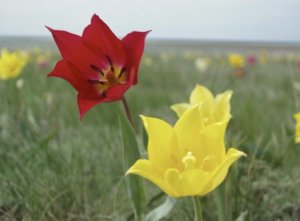
It grows in steppe zones and semi-deserts, has excellent aesthetic properties, and during flowering covers the meadows with a magnificent floral carpet of red, white, yellow or pale pink shades.
Botanical description
Schrenck's tulip (Tulipa schrenkii) is a wild, low bulbous plant that belongs to the genus Tulip of the Liliaceae family. However, many taxonomic analysts still refuse to recognize the Schrenck tulip as a separate species: earlier it was attributed to Tulipa suaveolens, today many identify it with Tulipa gesneriana.
The plant rarely exceeds 40 cm in height. On a leafless stem, there is a large cup-shaped bud, the size of which reaches about 7 cm, with six petals of a rich, colorful color, slightly pointed at the end. The color of the bud can vary from white and yellow to pink and purple.
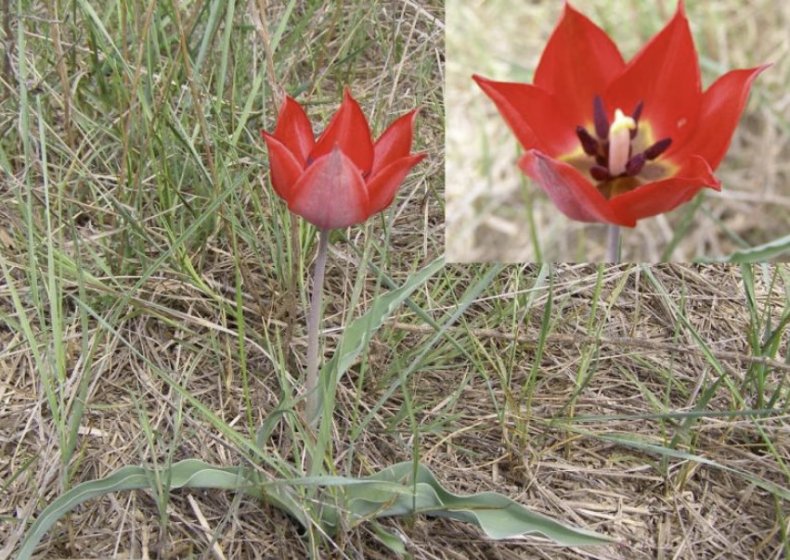
The fruit of the plant is a seed capsule, in which up to 240 seeds can ripen.
The bulb is small, 2.5-3 cm. It has the shape of an egg, covered with a layer of gray-brown scales on top. The onion sinks deep into the ground; during maturation, it forms only one kidney.
In honor of whom is it named
The tulip received its original name in honor of the famous biologist Alexander Ivanovich Shrenk, who in 1873, in one of his trips to Kazakhstan, discovered this new, amazingly beautiful, very fragile and delicate plant.
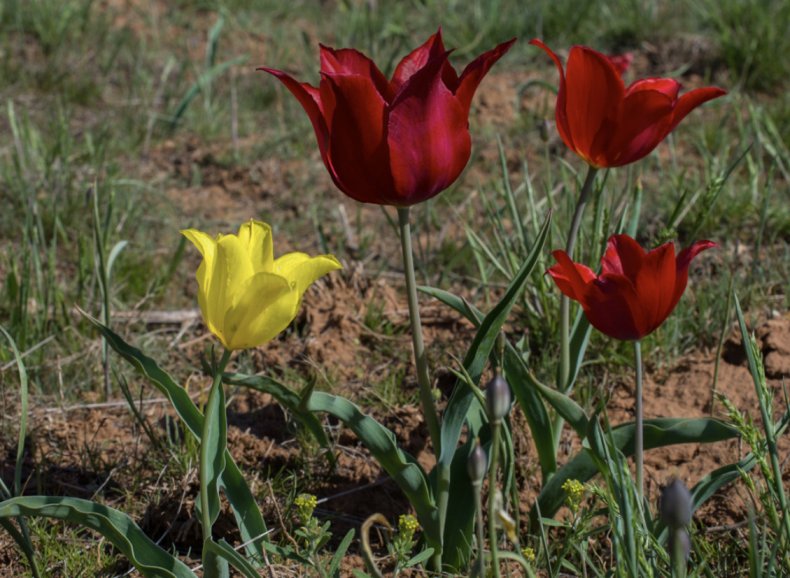
Distribution locations
The most comfortable habitats for this plant are considered to be steppe zones, semi-deserts, deserts, rubble trails of small mountains. It grows well on calcareous soils with a sufficient calcium content. It can often be found in saline soils. It takes root remarkably on chalky soils.
With regard to climatic conditions, Schrenck prefers zones where snowy and frosty weather prevails in winter, and warm, sun and low rainfall in summer.
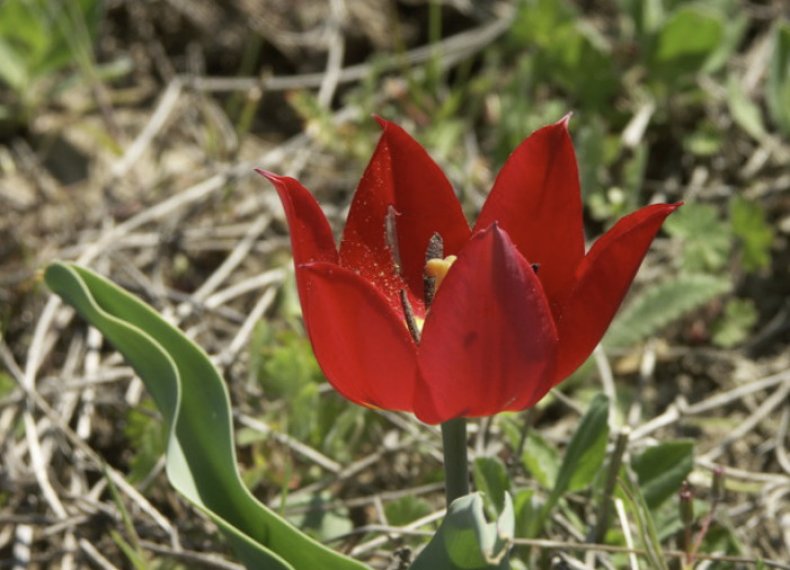
Why is it listed in the Red Book
Over the past few decades, this beautiful plant has become endangered. And the reason for this is human activity:
- regular plowing of the soil;
- grazing livestock on the land where the flower grows;
- pollution of soils with harmful chemical emissions resulting from industrial production;
- excavation of bulbs for use in the medical field;
- cutting flowers for implementation.
Due to such human intervention, the number of populations has rapidly decreased, natural selection has slowed down, and the area of plant growth has significantly decreased and continues to decrease.
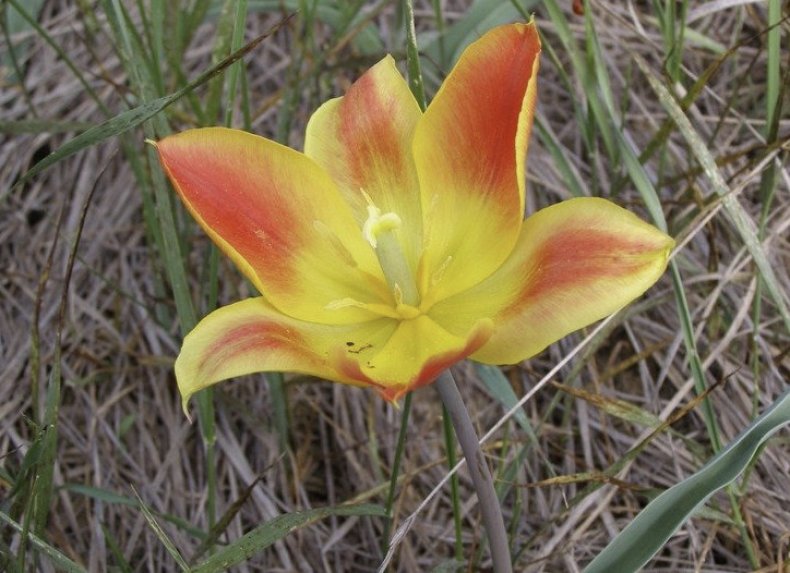
- patrolling the plantation during the flowering of the tulip;
- carry out explanatory work aimed at understanding the respect for nature;
- fine violators.
The flower is under protection in the Naurzum and Kurgaldzhinsky reserves.
Can I plant it at home
According to the legislation, Schrenck's tulip is a rare, unique plant on the verge of extinction, listed in the Red Book. It is forbidden to dig up the bulbs of the plant, which means that it is impossible to plant it in your garden within the framework of the law. For violation, appropriate penalties are provided.
If you nevertheless decide to purchase the bulbs or seeds of a plant for the purpose of planting them, then when carrying out planting work, you need to take into account the following aspects:
- the first flowering begins only 6-8 years after the planting of the crop; if the climate conditions are not comfortable, flowering may begin even later;
- you can propagate a flower exclusively by seeds;
- after the plant has faded, the bulb dies off and only one baby appears in its place, the flowering of which will begin a couple of years after the mother flower.
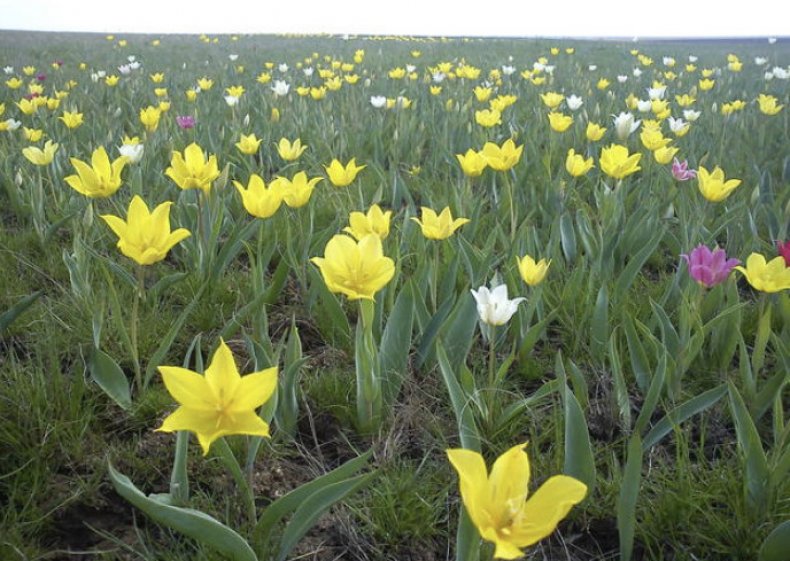
Growing a Schrenck tulip in a home is impractical, and even illegal. Therefore, it would be better to leave it in the wild and give us and our ancestors the opportunity to admire its beauty for many years.
9 reproduction
Both seed and vegetative propagation with the help of small daughter bulbs are possible.

9.1 Growing tulips from seeds
It is worth remembering that not all plants are capable of forming seeds after flowering. In addition, during seed reproduction, the varietal characteristics of the bushes are lost and the offspring are often strikingly different from the parent bushes in their appearance. Only species tulips fully retain their attractiveness with this method of reproduction.
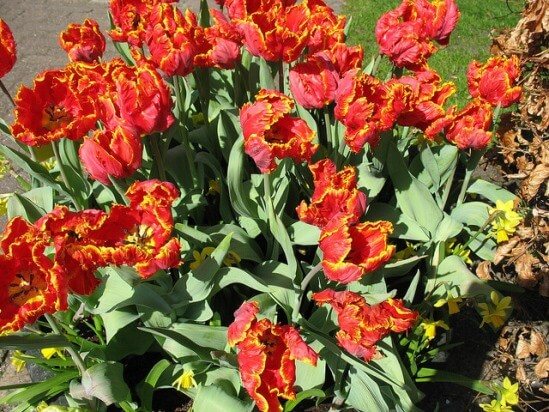
When growing a tulip from seeds, flower growers should be patient - the first buds will appear on such specimens only 3-7 years after sowing the seeds and the flowers can be small and inconspicuous. Full bloom often occurs only at 8-10 years of age.In everyday life, seed propagation is used extremely rarely, since the result is not guaranteed, however, it is often used by breeders to breed new varieties of flowers.
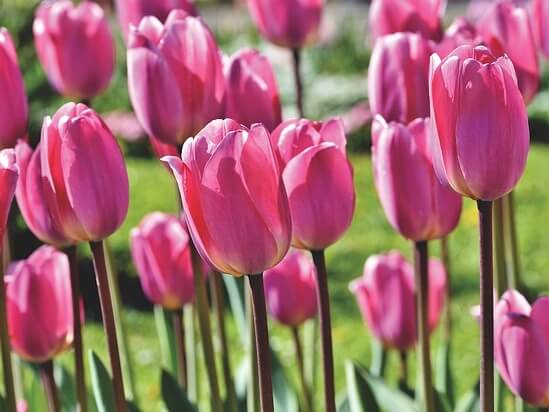
Seeds are picked from fully ripe seed pods and slightly dried in a warm and ventilated area. Sowing is carried out before winter in such a way that the sprouts do not have time to appear before the onset of winter. The seeds are placed in grooves about 1.5 cm deep, sprinkled with soil and, with the onset of night frosts, covered with non-woven material. The first shoots will appear only next spring.
Small bushes do not disturb the transplant for another 2 - 3 years, providing them with timely shelter in winter. Only in the fourth year are the bulbs dug up, dried and planted in the fall.
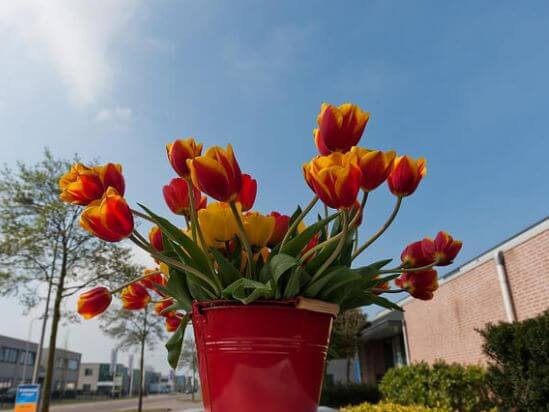
9.2 Propagation by daughter bulbs
Each year, during transplantation, daughter bulbs are separated from the mother plants, disinfected, then dried and examined. If there is damage or signs of disease, it is better to destroy the bulbs, and leave only healthy planting material for further breeding.
You may also be interested in:
- Sweet peas - planting and care, coloring the flowers of an annual plant, growing from seeds at home and in the open field, keeping on the balcony, varieties
- Pogonaterum - photo of indoor plants, home care, planting in open ground, description of varieties, flowering time, reproduction - growing from seeds, when to transplant a plant, watering and feeding, lighting, temperature
- Lavender - photo, planting and caring for a flower in the open field, growing from seeds in a pot, at home, the beneficial properties of lavender oil, flowering time, planting seedlings, plant application
- Indoor ivy - plant care at home, types of ivy, reproduction, flowering time, soil composition for planting indoor plants in pots
Small daughter bulbs in the first 2 - 3 years are grown in a separate place so that they do not interfere with adult plants to develop and form buds. If, during the first 1 - 2 years, young plants get confused to form flowers, then such buds must be removed - thereby accelerating the development of bulbs.
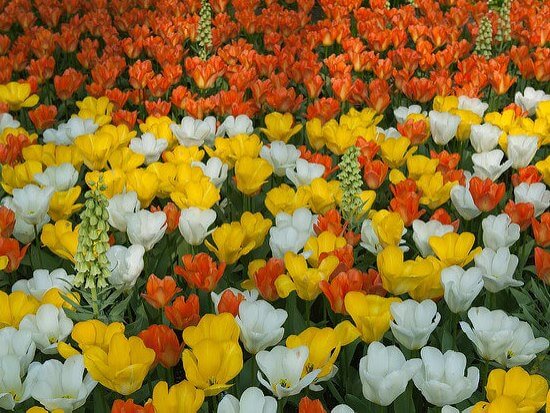
Schrenk's tulips in the Orenburg region

To meet a Schrenck tulip in the Orenburg region is a common thing. Combining parts of the European Plain, the south of the Urals and the Trans-Urals, a vast territory is rich in steppes, where this species grows. Schrenck's tulip is a blossoming symbol of the Orenburg region. It is impossible to compare the thick spring aroma that fills the steppe air when whole hectares bloom with anything. The region's red book also puts it under protection. But the tulip is loved and appreciated not only there.
In the Volgograd region in 2009, a natural monument of regional importance was established - the Kurnaevsky tulip meadow. It is located on a very extensive area of 418 hectares. Its special value is due to the fact that rare and rare plants grow there, including the Schrenck tulip. The regional authorities limit as much as possible the anthropogenic influence of the external environment on this territory in order to preserve the biosystem in its original form.
Growing
If you have a desire to grow a wild tulip in your garden, you should pay attention to some important points of this process.
First, you need to find a good landing site. It should be open, spacious, light and semi-shaded. Too shaded places are not recommended, and under the scorching rays of the sun, the plant will quickly wither
It is also very important to plant any varieties of tulips away from groundwater, which tend to wash away the root system of plants, as a result of which they begin to rot.
It is best to give preference to loamy and fertile soil when planting tulips.Ideal would be a neutral soil composition that you can fertilize yourself.
Tulips are planted in spring or autumn
The second option is more preferable and favorable.
The wells for the onions should be made small, but at a certain interval from each other. A little sand can be poured on their bottom to reduce the likelihood that the roots will rot in the future.
When the bulbs are planted in the fall, most of the bulbs will form the root system before winter begins. At the first frost, it is advised to cover the beds with tulips. For this, peat or humus can be used.

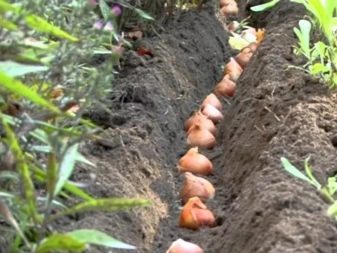
It is recommended to dig up tulips for the winter, and this should not be done at the end of summer, but almost always after flowering. Tulips, the bulbs of which have been in the ground all summer, usually shrink in subsequent flowering years. That is, the flower will become even more miniature. Dug up bulbs are usually disinfected, dried and put into boxes for the winter.

In order for the plant to grow healthy and bloom in due time, it should be properly looked after. Usually, complex fertilizing is done no more than 3 times per season. The first feeding is carried out before the emergence of tulips, the next - at the stage of bud ripening and, finally, during the flowering itself. Dry formulations of fertilizers can be used even when there is still residual snow on the ground, but fertilizers in a composition with potassium and phosphorus are recommended during flowering. Complex fertilizing can be applied while watering plants.
In general, caring for Bieberstein tulips is minimal. The main thing is to water the plants on time, but in moderation, and in no case overflow them. After watering, it is recommended to loosen the soil, which is very useful for perennial tulips.
It is also important to remove weeds and grass that grow near the tulips. Weeds not only pollute the area, but also pull nutrients from the tulips, which makes them sick and does not even bloom.
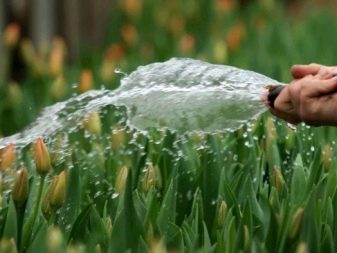

As for the prevention of insect attacks and the appearance of any diseases, it should be noted that both chemical and folk remedies can be used. For spraying, herbal tinctures of chamomile, dandelion and wood ash are often used, and a solution based on laundry soap is used as a home insecticide. Of course, such remedies may not completely get rid of annoying beetles or ants. Therefore, when attacking whiteflies or aphids, it is best to use ready-made preparations.
Bieberstein tulips look great in a variety of flower beds and alpine slides, they add a touch of brightness to them among other flowers. With very simple care, proper feeding and regular watering, the plants will annually delight with their flowering in the earliest spring.
For more information on the Bieberstein tulip, see the next video.
Bieberstein tulips
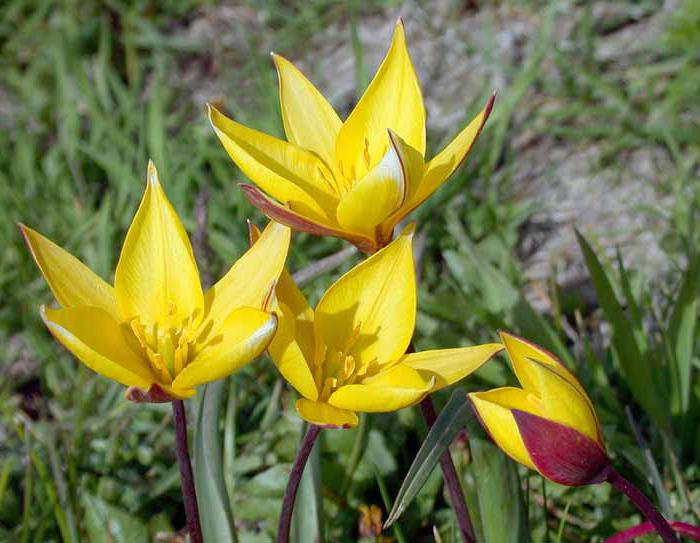
This is another species of wild tulips that was discovered by the German botanist Friedrich Bieberstein and named after him. In flower shape and other external phenotypic characteristics, they are very similar to the Schrenk variety. But there are two significant differences. Firstly, Bieberstein tulips are always bright yellow and nothing else, while their closest relatives are full of colors, like a kaleidoscope. In addition, the flowers are slightly smaller, on average up to 3 centimeters long. Secondly, they reproduce well not only by seeds, but also by daughter bulbs, which allows them to reproduce their numbers quickly enough. In Russia, they can be found in the Volga region, the Caucasus, Kalmykia, Western Siberia. But in the Rostov region, they are listed in the regional Red Book.
Agricultural machinery of tulips
Most tulip varieties bloom in May, so they are usually planted in the fall, around the second half of September.But often these flowers are grown commercially, and therefore sometimes need to be obtained in February - March or even earlier.
In this case, forcing the plant is used, which greatly weakens it and creates conditions in which a full-fledged bulb cannot form, but in this case flowers can be obtained at any time.
To speed up flowering by just a couple of weeks, you can plant tulips in unheated greenhouses in the fall. And if it is necessary to make them bloom in February - March, forcing is carried out with keeping the planting material at a temperature of + 9 ° C.
With the beginning of the growth of shoots, it is increased to + 15 ° С, and in the future - to + 18 ° С, but in no case higher. In this case, the flowers are planted in December. By the same principle, you can calculate how best to plant tulips, focusing on the desired flowering time.
Bieberstein tulip photo and description
Bulbous plant, perennial. The stem has two basal, linear, leaves. The bulb looks like an egg, has a black or brownish shell. Flowers until the blooming of the drooping species, as a rule, there are one of them per plant. This is how he is, the Bieberstein tulip, photo and description of which are given below.
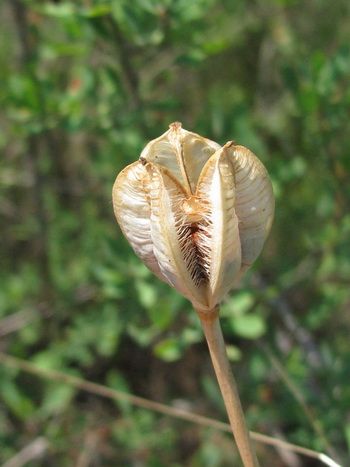
This tulip blooms in April or May. The fruit is formed in the form of a capsule, ripening at the very top. The plant can propagate by seeds, its bulbs are considered poisonous. The tulip of this species has sharply declined in numbers over the past few decades. In many areas, it is included in the lists of protected plants. The Biberstein tulip is bred mainly from the east of the Transcaucasus to the Upper Volga, in Central Asia, from Ukraine to Siberia. Most often, he prefers steppes or steppe slopes, forest-steppe areas, glades, forest edges for growth.
External description of the Biberstein variety and photo
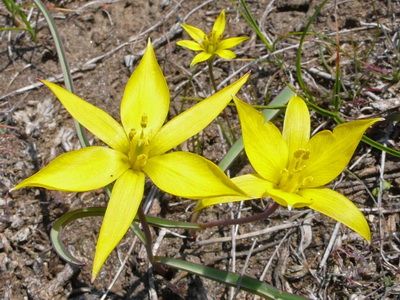
With the first positive temperatures, you can see this graceful plant, distinguished by an amazing delicate scent. The stem reaches a height of thirty to thirty-five centimeters, at its end there is a flower in the shape of a yellow star. The period of growth and flowering occurs at a time when the foliage on the trees has not yet blossomed and the plant receives sufficient illumination. When it decreases, the aerial parts of the tulip begin to gradually die off.
Tulip planting rules
The place for growing must be chosen correctly. It should be properly lit and protected from the wind. The groundwater level should be no closer than sixty centimeters from the root system, otherwise the bulb may well rot and die. The tulip prefers sandy loamy terrain, rich in humus, but not too acidic. A neutral soil composition is most suitable for growing it.
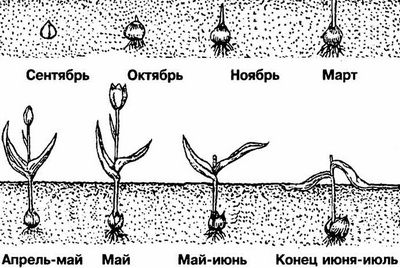
On the eve of planting, the bulbs should be examined, and diseased specimens should be selected that can transmit the infection to the soil or to neighboring plants. Planting rows are arranged at intervals of forty centimeters, the distance between plants is about fifteen. At the onset of the first frost, the beds must be covered for the winter, using foliage, peat or humus for this.
Organization of care
The plant must be fed at least three times. The first procedure is carried out when seedlings appear. For this, dry fertilizers are used, which are scattered directly onto the snow. The second time to resort to this method is necessary during the period of bud formation, introducing phosphorus and potassium compounds into the soil. And during flowering, the third procedure is carried out.
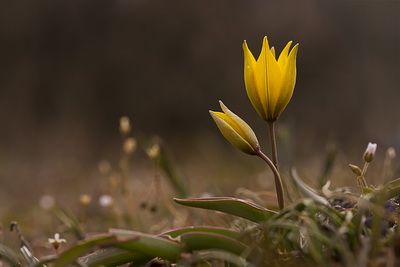
The plant is considered unpretentious, therefore, its care is minimal. The soil in the beds should be loosened, without weeds, slightly moistened. Periodic watering is carried out during the growing and flowering season. After the inflorescence wilts, moisture is added for a couple of weeks until the upper part of the plant begins to turn yellow. During this period, moisture is needed to feed young bulbs.The faded inflorescences are removed to preserve the strength for the plant to ripen the seeds.
Plants look great in central flower beds. They are successfully used to decorate alpine slides. With easy care, Bieberstein tulips will delight you with flowering in the spring season.
Tulips of traditional color
When composing bouquets of tulips, florists often rely on the symbolism of flowers:
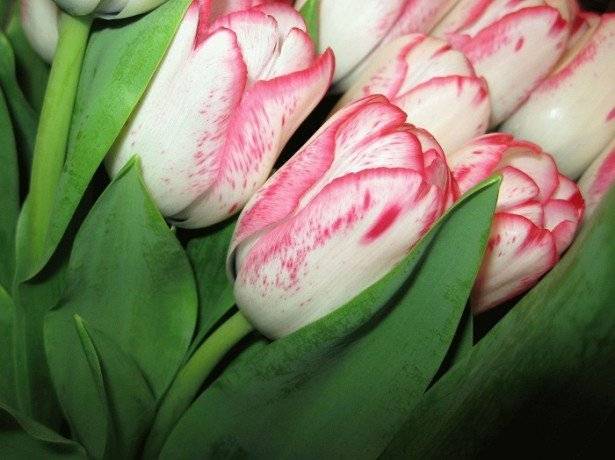
- it is customary to give red tulips to beloved ones, as a fiery declaration of love;
- snow-white tulips are considered a symbol of forgiveness;
- yellow tulips used to be presented as a sign of separation, but now a yellow bouquet is perceived as a wish for wealth;
- delicate flowers of pink shades symbolize happiness;
- sunny orange tulips seem to radiate cheerfulness, they serve as a vivid confirmation of the kindest and most positive wishes.
But it's one thing to give bouquets of tulips, and quite another to grow them in your flower garden. Here you can give free rein to imagination, without worrying about what black or purple tulips may symbolize. And if it is still difficult for you to navigate in the widest assortment of tulips of various varieties and shades, in our article you will find the most popular varieties of all colors that have just been bred by breeders.
Video about varieties of tulips
Red
Of course, red tulips look brightest on flower beds in spring, photos of which are presented in huge numbers on the Internet. It's safe to say that there is a spot for brilliant fiery red tulips in almost every flower garden. In addition, the choice of red varieties is very wide: the majestic Red Emperor tulips (buds fully open), bright Garden Spot and Arie Hoek (do not bloom in the sun), dark red Oscars, Red President, Boston, Madame Curie, widespread Parade, Oxford, terry like a peony Miranda, fringed tulips Edda, Fringed Apeldoorn, Redwing, Minstrel, etc.
Pink
If you want to give your flower garden a delicate, romantic look, pink tulips are best suited for this purpose. Among the widespread varieties of pink color, there are real pearls: amazing in its simple beauty, the Apricot Beauty variety of a soft salmon shade, the pearl pink densely double variety Angelica, the lily-shaped pink tulips Pritti Lady, the creamy pink chameleon tulips New Design (Triumpurnof group), purple pink Barcelona, fringed tulips New Look with pink petals and white fringes, lingonberry pink Bellflower with light fringes and cherry pink Brandburg with white fringes.

Pink tulips
Yellow
Like little suns, yellow tulips will liven up your garden and help create a cheerful spring mood. How festive and bright yellow tulips look on the flower bed, the photos cannot fully convey - it is worth seeing with your own eyes!
Choose the best varieties: golden large tulips Golden Apeldoorn, peony Yellow Pomponet of deep yellow color, luxurious double Monte Carlo, elegant Texas Gold parrot tulips, dense Mon Amour, canary fringed tulips Laverock and yellow buttercup yellow.
Orange
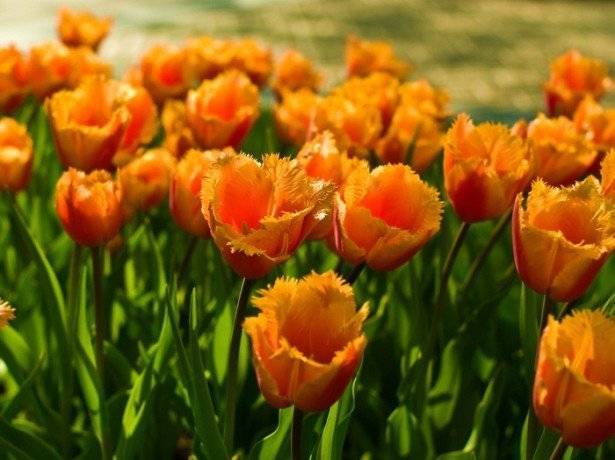
Orange Terry Tulips
Orange tulips, bright and sunny, like spring itself, will be a great addition to the spring flower arrangement on the flower bed! Among the orange tulips, it is worth noting such varieties as the terry Willem Van Orange, the densely doubled Orange Princesses with orange-reddish flowers, the Green River variety of an intense orange-pinkish color, graceful Greig tulips, the fringed Lambada flowers, combining several shades of a warm range.
White
If you like sophisticated, exquisite flowers, white tulips are the perfect option for decorating your flower garden! A flawless white tulip blends perfectly with other flowers of all shades, allowing you to create a variety of compositions in the garden - check out the options for combining tulips with other plants.
Popular varieties of white tulips: pure white terry Cardinal Mingenti, creamy white lily-shaped Purissima, fringed Swan Wings and Honey Moon (how amazing these white tulips are, the photo in the tab will give you an idea), soft cream terry Casablanca tulips, lush terry tulips Ice Wonder flowers with pink spots on white petals, a new variety Angels Wish with large snow-white glasses.

Tulips varieties "Casablanca"
Schrenck's tulip: description
Wild tulips are of medium size. But Schrenck's tulip boasts distinctive large features. It has a very miniature egg-shaped bulb, 1.5-2 cm in diameter. But the plant itself grows up to 30-40 centimeters in height. It has green leaves with a blue tint, lanceolate, slightly wavy, usually 3 or 4, the lower one is always larger than the rest.
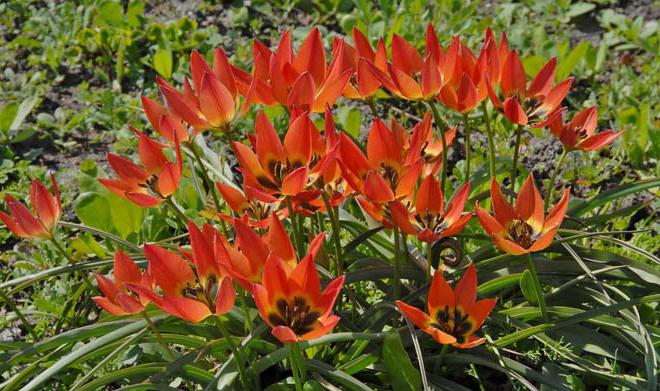
The flower has a rather variable shape, most often a cupped bottom and six petals, pointed at the end, like lilies. Unlike artificially bred varieties, it has a light and pleasant aroma. The size of the flower is 7 centimeters in height. The color can be different: red, orange, yellow, snow-white and even almost purple, variegated forms are also found. The Schrenck tulip is a medium-flowering tulip that blooms from the end of April to the whole of May. Propagated in nature by seeds that ripen in sufficient quantities in June.
Popular message topics
- Why are punctuation marks needed Oral and written speech of a person is a complex system of relationships of various structures, without which understanding the text in writing and communication of people would be impossible. However, in order for the meaning of the text to be clear to everyone, it is necessary
- Water hardness and its elimination Water hardness is understood as the presence in it of such physicochemical properties that are associated with a certain amount of dissolved alkaline earth metal salts in water, most often magnesium or calcium.
- Obsolete words The written and oral speech of a modern person is represented by a huge variety of words that help to correctly express thoughts. Most of them are the words that are familiar to us, people use them every day.
Generations of tulip bulbs
Speaking about the structure and characteristics of the tulip, it is important to note that during a certain period of life (February-May), the tulip bulb has 3 generations:
- 1st generation - mother bulb
- 2nd generation - daughter bulbs
- 3rd generation - the rudiments of daughter bulbs (granddaughters) inside the daughter bulbs of the 2nd generation
By the time of digging, the mother bulb has died, and the daughter bulbs (2nd generation) are separated. The central daughter bulb turns into the mother (replacement), and the rest into smaller bulbs (baby). The buds of daughter bulbs - granddaughters (3rd generation) turn into daughter bulbs and when the bulbs are planted, the cycle repeats.
Despite the fact that the aboveground part and the root system of the tulip are renewed annually, the bulb with the rudiments of all organs lives for 2.5 years, as a result of which the tulip is a perennial plant. But in the bulbs of wild tulips, the characteristics are more persistent - in nature they live up to 50 years.
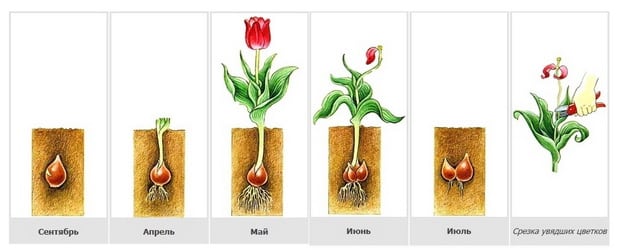
A root ridge is located along the edge of the bottom, from which several tens of smooth, unbranched roots develop. Even under favorable conditions, their length does not exceed 50 cm.
In non-flowering (juvenile) bulbs, the replacement bulb is formed on the stolon and deepened, although the bottom of the mother bulb with the root system is at the planting level.The formation of stolons is also observed in wild species, which mainly reproduce by seeds.
The seeds of wild tulips fall to the ground and the resulting bulb, being shallow from the surface, is exposed to unfavorable climatic influences.
To weaken them, the bulb deepens annually (for 5-7 years) and, only after reaching the flowering period, the formation of stolons and further deepening of the replacement bulb stop. In flowering tulips, the replacement bulb and babies are usually located at the planting level.
Next, you can see the photo and description of the leaves and flowers of the tulip.


